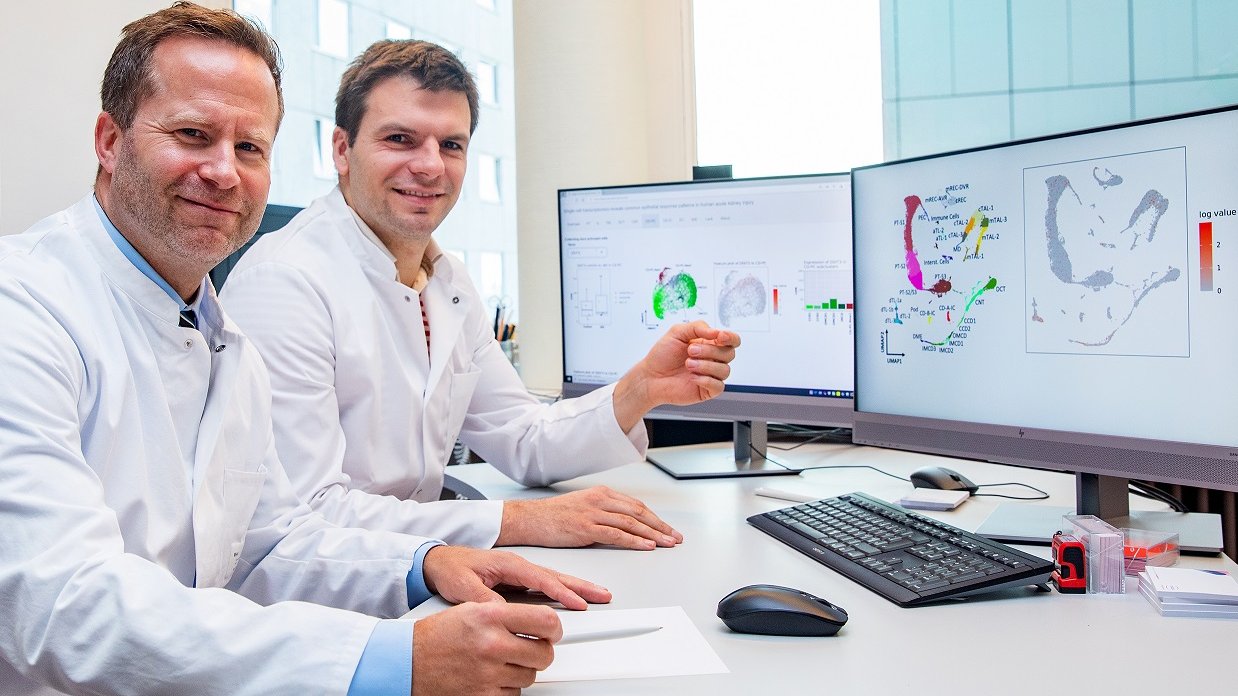Professor Dr. Kai Schmidt-Ott is increasingly focusing on single-cell sequencing and bioinformatics in his clinic.

Clinic director Professor Schmidt-Ott (left) and his senior physician Dr Christian Hinze rely on bioinformatics for better therapies for acute kidney damage. Copyright: Karin Kaiser/MHH
Stand: 29 November 2022
Whoever takes over a clinic management usually brings something with him: new ideas, research cooperation and proven staff. This is also true for Professor Dr. Kai Schmidt-Ott, who took over the management of the Clinic for Renal and Hypertension Diseases six months ago. He has taken senior physician Dr. Christian Hinze with him from Charité University Medicine Berlin - and with him the know-how of a method that both want to develop further at the MHH. Single-cell sequencing is the name of the method that makes it possible to look deep into the biological processes of individual cells. A few weeks ago, the physicians published two studies in the journals Genome Medicine and Kidney International that show the molecular pattern of acute damage to human kidney cells.
Direct zoom into the cell
"Acute kidney damage is associated with a wide variety of diseases," says Professor Schmidt-Ott. The complication often occurs with cardiovascular diseases or severe infectious diseases - such as COVID-19 - but also after operations, when taking drugs that are harmful to the kidneys or as a result of certain autoimmune diseases. The problem for the treating physicians is that, in view of the large number of possibilities in individual cases, they often do not know which cause has led to the kidney damage. Also, there is often no specific drug for the treatment. "For us, single-cell sequencing is a special camera, so to speak, with which we can zoom directly into each cell and see what is happening there," explains Dr Hinze. What exactly happens when in a particular cell is indicated, among other things, by its transcriptome - the totality of all genes that are read and transcribed into RNA at a specific point in time. With the help of single-cell RNA sequencing, thousands of cells can thus be analysed in parallel and individually. This allows the researchers to see whether the kidney cell is functioning properly, whether it is under stress or is dying. "The kidney itself provides information about what is going on with it," explains the nephrologist.
Approach for personalised therapy
And that is important, because the problem of acute kidney damage is often underestimated. "It is associated with increased mortality, and patients can suffer permanent damage or even complete loss of kidney function," emphasises Professor Schmidt-Ott. The trigger is often an insufficient blood supply to the kidney, so that the cells there no longer receive enough oxygen and nutrients. They go into a kind of alarm mode and produce signalling substances that lead to inflammation and scarring processes in the surrounding tissue. In their studies, the researchers examined cells from tissue samples and urine from more than 40 patients and analysed the molecular patterns of more than 140,000 cells with the help of computers and compared them with each other. "We were able to identify certain molecular patterns that occurred individually at different frequencies in all those affected with acute kidney injury," says Dr Hinze. "In future, these findings could help to better assess risks for severe disease progression and offer promising approaches for future diagnostic procedures and personalised therapies."
Competence in bioinformatics in demand
But this requires not only medical expertise, but also computer science expertise. "Analysis provides us with a flood of data that is only useful once it has been evaluated and classified," Professor Schmidt-Ott emphasises. And because medicine is increasingly faced with the problem of generating more and more data with ever more elaborate methods, the clinic director believes that more competence in bioinformatics is needed among researching physicians. He and his senior physician, who also holds a degree in mathematics, cannot complain about a lack of interest among his MHH colleagues. "We get a lot of positive feedback and, with the Peter L. Reichertz Institute for Medical Informatics, we have other experts at our side with whom we can exchange experiences."
Author: Kirsten Pötzke